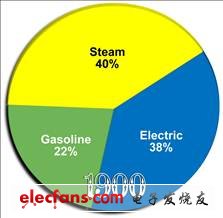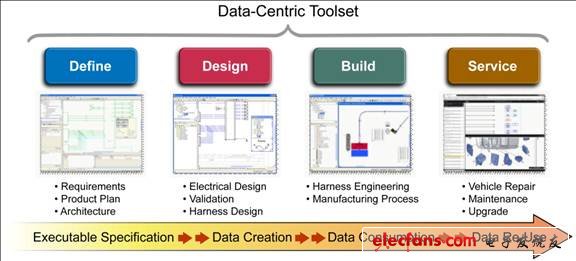introduction
Automotive designers are currently facing a new and old challenge: that is to develop a new and efficient electric vehicle platform. The history of electric vehicles is almost as long as traditional fuel vehicles, but for most people today they are still "new things."
In 1900, the American automobile market was basically composed of three propulsion systems (see Figure 1). Gasoline cars rank third, with a market share of only 22%.

Figure 1: Electric vehicles peaked around 1900, when they surpassed internal combustion engine vehicles.
But 1900 was the culmination of electric vehicles. Soon, with the discovery of large amounts of oil, gasoline became popular and cheap. The dominance of gasoline-powered cars has been established, and basically has not been challenged for the next century.
Increasing oil price pressure and environmental issues have forced the automotive industry to seriously consider electric propulsion systems. Designers need some tools to accelerate the development of safe, reliable, and economical electric vehicles for the future market.
It all starts with battery technology
Today's complex battery technology achieves high energy density, reasonable quality and proper charging time. Many modern battery packs use chemical elements such as lithium ion, which can increase mileage and reduce weight. However, if the gasoline energy density of 12 kWh / kg is compared with 0.12 kWh / kg 2 of ordinary lithium-ion batteries, even if the "best" battery drives a four-door passenger car, it can only run at most per charge. 250 kilometers (150 miles) 3.
Designing battery-powered vehicles (and ultimately achieving the goal of all electric vehicles being battery-powered) is a challenge that involves multiple fields-if there are no software tools to help engineers design light-weight, low-cost power distribution systems; establish sophisticated Battery operation, charging and demand simulation models; predicting safety and electrical interference issues, and still meeting the urgent new product development schedule, this challenge is difficult to solve.
Hybrid electric vehicles pose design challenges
Now consumers must weigh the major trade-offs compared with traditional fuel vehicles when buying electric vehicles. Relatively high purchase prices, battery replacement costs, and limited mileage are enough for consumers to pursue traditional fuel vehicles, and the disadvantages are not limited to these.
Many original equipment manufacturers choose to use electric and traditional fuel engine technology to produce hybrid vehicles. These platforms take advantage of both battery and traditional technology.
The battery of a hybrid car is smaller than that of a pure electric car because it is only used intermittently. The smaller battery pack makes it easier for designers to design it into the car, while keeping the car cost and weight under control. The battery can be charged while the car is running. However, the propulsion technology of hybrid electric vehicles (and many derivatives) and pure electric vehicles has significantly increased the electrical content and complexity of vehicles.
All electric vehicle platforms will bring many new design challenges, including system simulation, electromagnetic interference (EMI), failure mode and effect analysis (FMEA), potential path analysis (SCA), and so on.
Design data management is the core of solving the complexity of electrical design. The data-centric power distribution system (EDS) design toolkit (shown in Figure 2) plays this core role, supplemented by other tools selected based on their respective AC analysis capabilities.

Figure 2: The data-centric process provides a consistent data foundation throughout the design process from product definition to repair point.
Simulation, modeling and parametric analysis work together
Hybrid vehicles and electric vehicles undoubtedly increase the complexity of the simulation. Traditional simulation scenarios are inseparable from qualitative logic current or numerical DC simulation engines, but they cannot handle multiphase AC voltages and currents and switching frequencies up to 50 kHz. In addition, the enhancement of the interaction between the various automotive system domains also makes the verification of multi-model systems a key consideration.
When a designer equips a car with both a traditional gasoline engine and an electric motor in a "similar" hybrid configuration, in addition to simulating the common DC weak current circuit behavior, the designer also has to evaluate various interactions , Including the impact of the DC-DC converter on the entire vehicle.
Multiphase alternating current powers the electric motor. This requires new simulation and modeling techniques to maximize battery optimization, extend driving range, reduce weight and shorten charging time. Finally, the designer must be able to take a closer look at the interaction of the electric motor, gasoline engine, gearbox and drive system under different driving cycle conditions.
The comprehensive distribution system design platform can easily realize the qualitative and numerical analysis of DC circuits. Battery and engine behavior can be described in formats such as VHDL-AMS to simulate effects such as temperature or charging effects. Engineers can create a “demand model†based on the driving cycle and determine the optimal combination of battery and engine by operating a series of scenarios.
When more detailed research is needed, the power distribution system platform can send data to a compatible time domain / AC analysis tool to evaluate the multi-physics characteristics of the design (see Figure 3). Advanced drive system control algorithm models, engine-driven power electronic component models using space vector modulation conversion strategies, and accurate mechanical models based on finite element analysis (FEA) can be almost assembled and simulated into a fully integrated system.
Introduction
SCOTECH`s Vacuum Pressure Impregnated Transformer (VPI transformer) is non-cast insulation that provides an excellent level of environmental production. The higher thermal class of insulation provides for a compact and reliable transformer from very lower power rating up to several MVA, VPI transformer can be supplied with either aluminum or copper windings. Our VPI transformer are used in many varied applications such as industrial, renewables, railways, marine, distribution and power generation.
Advantages
Perfect solution for low voltage transformer and inductors.
From IP00-IP56 with AN, AF, ANAF, or AFWF cooling
Reliable quality
Compact size
Scope of supply
Voltage level: up to 35KV
Rating level: up to 20MVA
Standards
SCOTECH`s dry type transformers are designed and manufactured in accordance with all major international standards (IEC, ANSI, UL, CSA etc.)
Why SCOTECH
Long history- Focus on transformer manufacturing since 1934.
Technical support – 134 engineers stand by for you 24/7.
Manufacturing-advanced production and testing equipment, strict QA system.
Perfect service-The complete customer service package (from quotation to energization).
Vacuum Pressure Impregnated Transformer
Vacuum Impregnated Transformer,Medium Voltage Dry Type Transformer,Vacuum Pressure Impregnated Transformer,Vacuum Pressure Impregnated Dry Type Transformer
Jiangshan Scotech Electrical Co.,Ltd , https://www.scotech.com